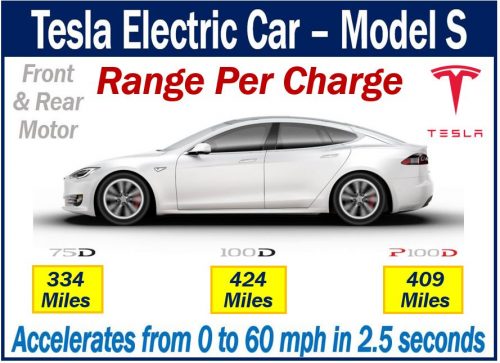What is an electric vehicle? Definition and example
An electric vehicle is a vehicle that runs fully or partially on electricity. Unlike conventional vehicles that just use fossil fuels, e-vehicles use an electric motor that is powered by a fuel cell or batteries. We can also use the terms ‘e-vehicle‘ and ‘EV.’
In most cases, including this article, the term includes both BEVs and PHEVs. The letters BEVs stand for battery electric vehicles while the letters PHEVs stand for plug-in hybrid electric vehicles.
Electric Vehicles News says that an e-vehicle is:
“A vehicle which uses one or more electric motors for propulsion. Depending on the type of vehicle, motion may be provided by wheels or propellers driven by rotary motors, or in the case of tracked vehicles, by linear motors.”
“Electric vehicles can include electric cars, electric trains, electric trucks, electric lorries, electric airplanes, electric boats, electric motorcycles and scooters, and electric spacecraft.”
What type of electric vehicle is a BEV?
A battery electric vehicle runs exclusively on electricity. It gets the electricity from on-board batteries. To charge the car’s batteries you will need to plug it into a charging station using an EV charging cable. This will then recharge the battery for your next journey.
BEVs have no gasoline or diesel engine. They also have a longer electric driving range than a plug-in hybrid electric vehicle.
When you drive a BEV, the vehicle does not produce tailpipe pollution, i.e., there are no exhaust fumes. In fact, it does not even have a tailpipe (exhaust pipe).
Even though the vehicle itself does not pollute the atmosphere, the generation of electricity that it uses might. There is no pollution if the electricity comes from solar power, wind power, or hydroelectricity.
Solar power or solar energy captures the Sun’s energy and converts it to electricity. Wind power captures the energy from moving air and converts it into electricity.
Regarding using electricity rather than fossil fuels, the Union of Concerned Scientists says:
“Not using gasoline or diesel also means that battery electric cars are significantly cheaper to fuel than conventional vehicles. Exact comparisons depend on the vehicle model and fuel prices, but driving a BEV can save drivers over $1,000 annually in gasoline money.”

What type of electric vehicle is a PHEV?
A plug-in hybrid electric vehicle is a vehicle that uses both electricity and gasoline. Its electric motor powers the car for part of its journey before the combustion engine (engine that uses gasoline) starts up. It may just use electricity if it is not a long trip.
A PHEV is different from a hybrid electric vehicle (HEV). The HEV charges its own batteries using the petrol engine while it is moving. You do not plug it in, unlike a PHEV.
In a Daily Telegraph article, Ed Wiseman writes the following regarding PHEVs:
“These cars can be plugged-in to the national grid by means of a cable, as you would an electric car. This will charge the car’s batteries, enabling some electric-only range (usually between 20 and 40 miles) and usually reducing the amount of petrol used over longer journeys.”

Recharging batteries vs. filling up the tank
The traditional combustion engine gasoline or diesel vehicle has one huge advantage over the electric vehicle. It takes just one or two minutes to fill up a traditional car’s tank with gasoline.
To recharge the batteries of an e-vehicle, on the other hand, takes several hours. It is possible to ‘half-charge’ some EVs in less time. However, even then, we’re talking about at least forty-five minutes.
During recharging, you have to physically connect the e-vehicle to a plug socket. This makes the ownership of an EV virtually impossible for people who do not have their own driveway or cannot recharge at work.

